Almond Cely McLaughlin (1840 - 1905)
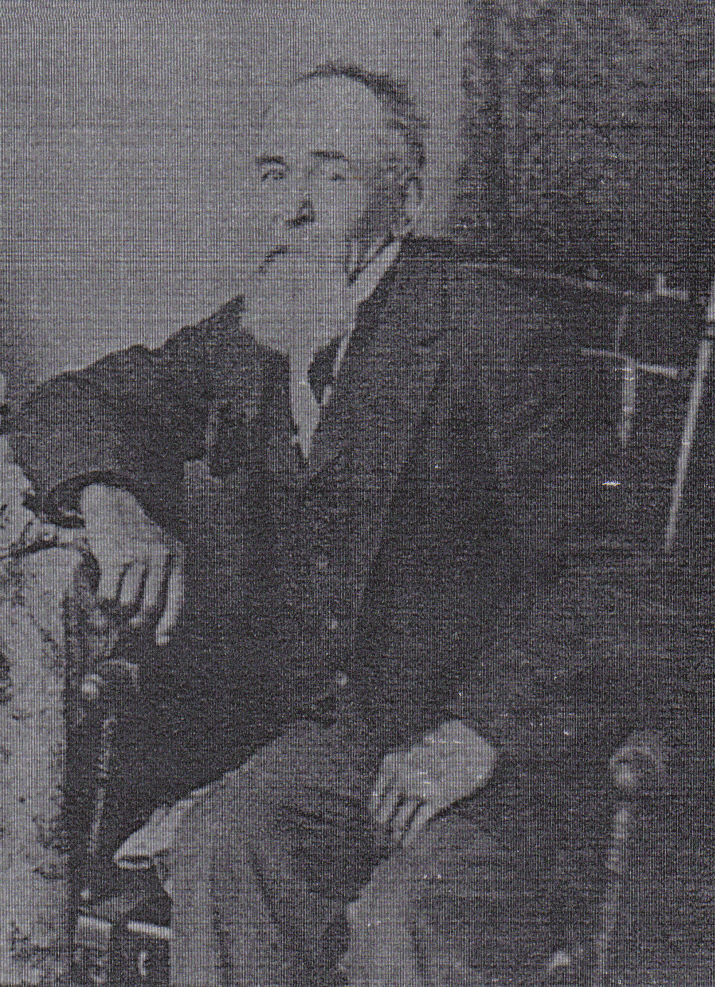
Links for Almond McLaughlin
Almond McLaughlin History
Almond Cely McLaughlin was born April 16, 1840 at Mt Vernon, Illinois to Edward Rooles Mclaughlin and Phebe Masterman. He was the 6th of nine children.
In the census of 1850, taken on June 1, Almond was 10 years old. He is listed as "Almon" and that he had attended school in the past year. The family was living in Salisbury, LaSalle, Illinois.

Almond C Mclaughlin 1850 Census(
Entire page
)
Sometime before the 1857 territorial census of Minnesota, taken on October 2, 1857, Almond had left home and was living in Stillwater, Washington, Minnesota, which is just east of Minneapolis. He is listed as "Almon McLaughlin". His occupation is listed as a clerk. His "household" is four other men ranging in ages from 23 to 40.

Almond C Mclaughlin 1857 Minnesota Territorial Census(
Entire page
)
In the 1860 US census taken on July 3, 1860, Almond is still living in Stillwater, Washington, Minnesota but in the home of Saul and Bernice Snafler (or Snapler). His occupation is listed as a logger. Note here his first name is spelled as "Almond".

Almond C Mclaughlin 1860 Census(
Entire page
)
Below is a picture of Stillwater in the 1860's.
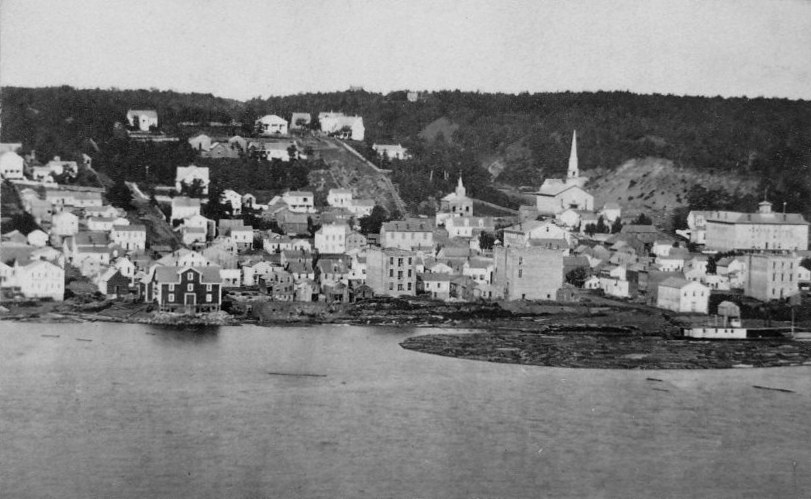
Stillwater, MN in the 1860's
In February 1961 seven of the 34 states declared their secession from the U.S. to form the Confederate States of America. Hostilities broke out April 12, 1861 at Fort Sumpter, South Carolina. On April 15 President Abraham Lincoln called for 75,000 volunteers from the different states for 90 days. On April 14, 1861, Minnesota Governor Alexander Ramsey, visiting Washington, tendered the 1st Minnesota Volunteer Infantry to the Federal government under Abraham Lincoln's call for troops. It (the regiment) was organized at Fort Snelling, Minnesota, on April 29 and re-mustered for three years service on May 10. (source).
Almond was among the first group of volunteers on April 29, 1861. He was enlisted as a private in the Minnesota 1st Infantry Regiment, B Company. B Company was primarily recruited from Stillwater where Almond lived.

Almond Muster-in record(
Entire page
)
The mustering-in took place at Fort Snelling, Minnesota. Company B's leader Captain was Carlisle A Bromley. The Regiment Colonel was Willis A Gorman. During the Civil war Fort Snelling was used as a training center. "The regiment quickly filled with enthusiastic men from all parts of Minnesota and was one of the few regiments that received training by a qualified officer. Colonel Gorman was a demanding but competent taskmaster"(source).
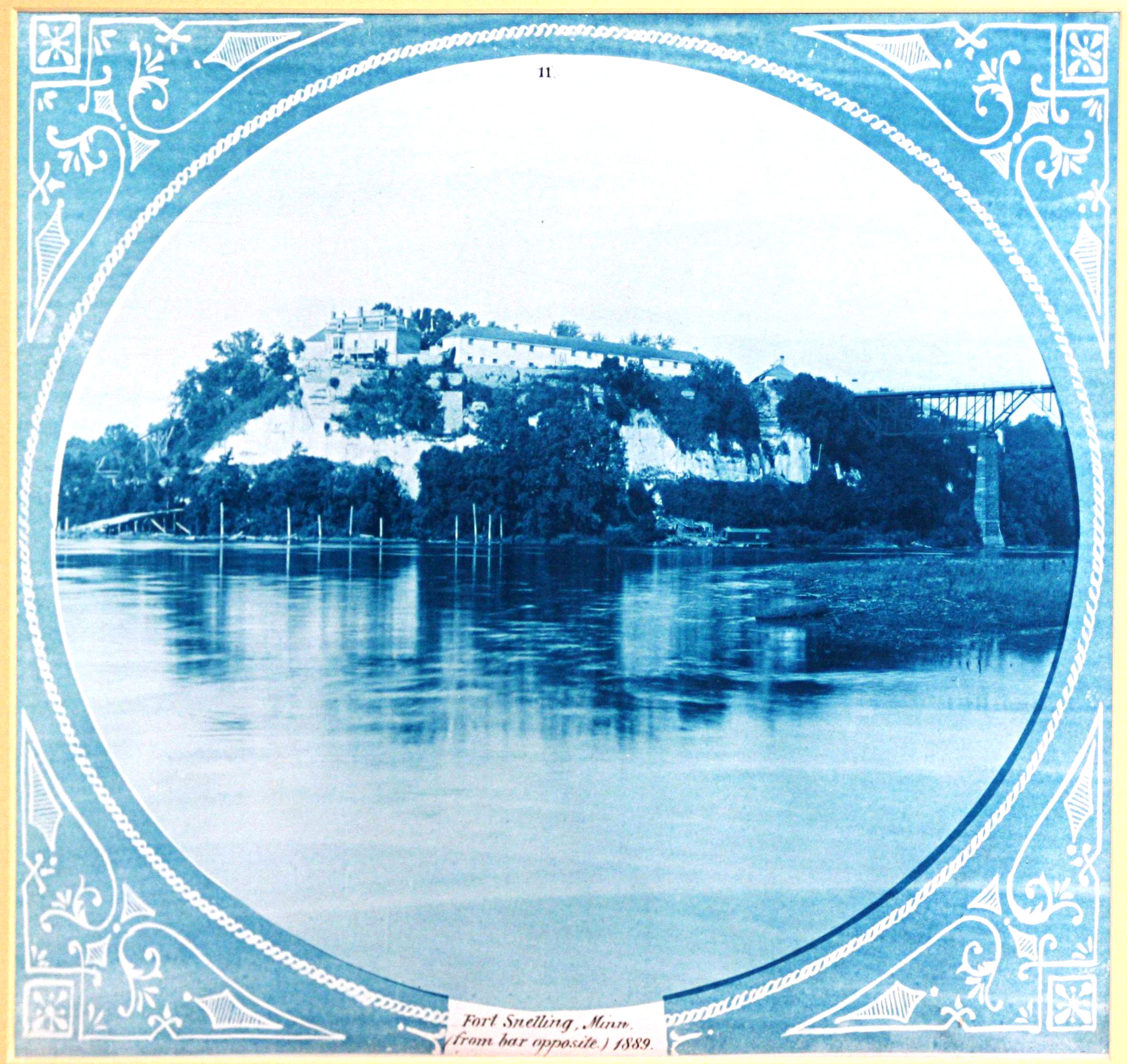
Ft Snelling, Minnesota 1889
(By Henry Peter Bosse - Views on the Mississippi River: from negatives taken and printed under the direction of Major A. Meckenzie, Corps of Engineers, U.S.A by H. Bossee, Draughtsman, 1883-1891., Public Domain, Link
The First Minnesota was first ordered to the frontier to replace the U.S. Infantry units that manned the frontier forts Ripley(Co. B and G), Ridgley( Co. A and E) and Abecrombie(Co. C and D) . By mid June, the regiment was ordered to Washington D.C. and the men left the forts to soldiers of the 2nd Minnesota.(source)
First Battle of Bull Run (July 21, 1861).
The First Minnesota was heavily engaged at the battle of Bull Run. They arrived at the battlefield at 11:30 and were ordered to support Rickett's Artillery Battery located on Henry Hill. The regiment was split into two groups with Lt. Colonel Miller in charge of Co. A and F on one side of the battery and Colonel Gorman commanding the rest of the regiment on the other side. As the regiment moved forward, there was some confusion between the two sides since both armies had troops wearing red shirts or grey uniforms. The confederates were the first to recognize the men in front of them with red shirts were the enemy and fired the first volley.
Dozens of men in the First Minnesota went down. Colonel Gorman gave the order to fire and for the next ten to fifteen minutes the two sides fired as fast as they could load. The regiment fought in an open field while the confederates stood at the edge of a wooded area. As the two sides exchanged fire the regiments on the flanks of the First Minnesota began to retreat. As they did so, the rebels concentrated more fire on the regiment and Gorman realized they too would need to pull back or be destroyed. There was no time to help their wounded off or retrieve their dead and the men fell back in reasonably good order, though some men did flee in panic. Since the First Minnesota was one of the last regiments off the battlefield, Gorman offered to cover the retreat but the task was given to a regular US infantry regiment. The regiment suffered over 200 casualties in the battle and was widely praised for their determined stand (source).
Almond survived the first Battle of Bull Run unwounded.
Battle of Savage Station (June 29, 1862).
The First Minnesota was part of the Union retreat and fought a rearguard action that became known as the battle of Savage Station. They fell in to support General Burn's Brigade at 4:00 PM on June 29, 1862 and were placed on the left of the brigade and quickly found themselves outflanked. The regiment wheeled their leftmost companies to face the flanking fire and fought for a time with little support. William Lochren of Co. E stated in a letter to the Pioneer and Democrat: On we went in the face of their fire, the shells frequently tearing through our ranks. One of them struck a German in Co. A but a few feet from me, passing through him and tearing the shoulder off the man in his rear ... When we got near the rebels, they gave us canister, killing and wounding several. Then the revels advanced their infantry, and at it we went. The rebels made several desperate efforts to drive us from the position we had taken, but they were continually repulsed. In due course General Sumner sent in two regiments to support the First Minnesota and the rebels pulled back. It was now dark and the regiment was forced to leave their wounded behind when they were ordered to continue the retreat (source).
Almond again survived this action unwounded.
Battle of Antietam (September 17, 1862).
The First Minnesota was down to 435 men when they entered the battle of Antietam. They were part of General Gorman's brigade and positioned on the far right of Sedgwick's division and were ordered to advance at 7:20. They first forded Antietam Creek and the division formed a line of battle near Neikirks's farm. They passed through the East Wood with dead and dying under the trees from previous fighting and soon emerged into a clearing and then over fences straddling the Hagerstown Pike. They now encountered fire and Color Sgt. Sam Bloomer fell with a leg wound. Then they advanced north of Dunker Church and into the West Woods. Here they drove the Confederates before then came to a clearing with enemy cannon targeting them. The regiment was still in good shape but the regiments to their left were under heavy fire and rebel reinforcements were rushed in and it looked like the Segwick's division was about to be flanked. As the regiments to their left fell apart, Colonel Sully ordered the 1st Minnesota to retreat to the north. The regiment did so deliberately, pausing to to stand and check the advancing confederates. This continued until they came to a stone fence where other regiments joined them along with a battery of artillery. The regiment held this position until the end of the battle and considered themselves fortunate compared to the rest of their division. The First Minnesota had over 100 casualties. Co. L (Sharpshooters) was hit hard with over 20 wounded (source).
Almond again survived unwounded.
On the Company B Muster Roll for December 1862, Almond was listed as "Sick in the Hospital".
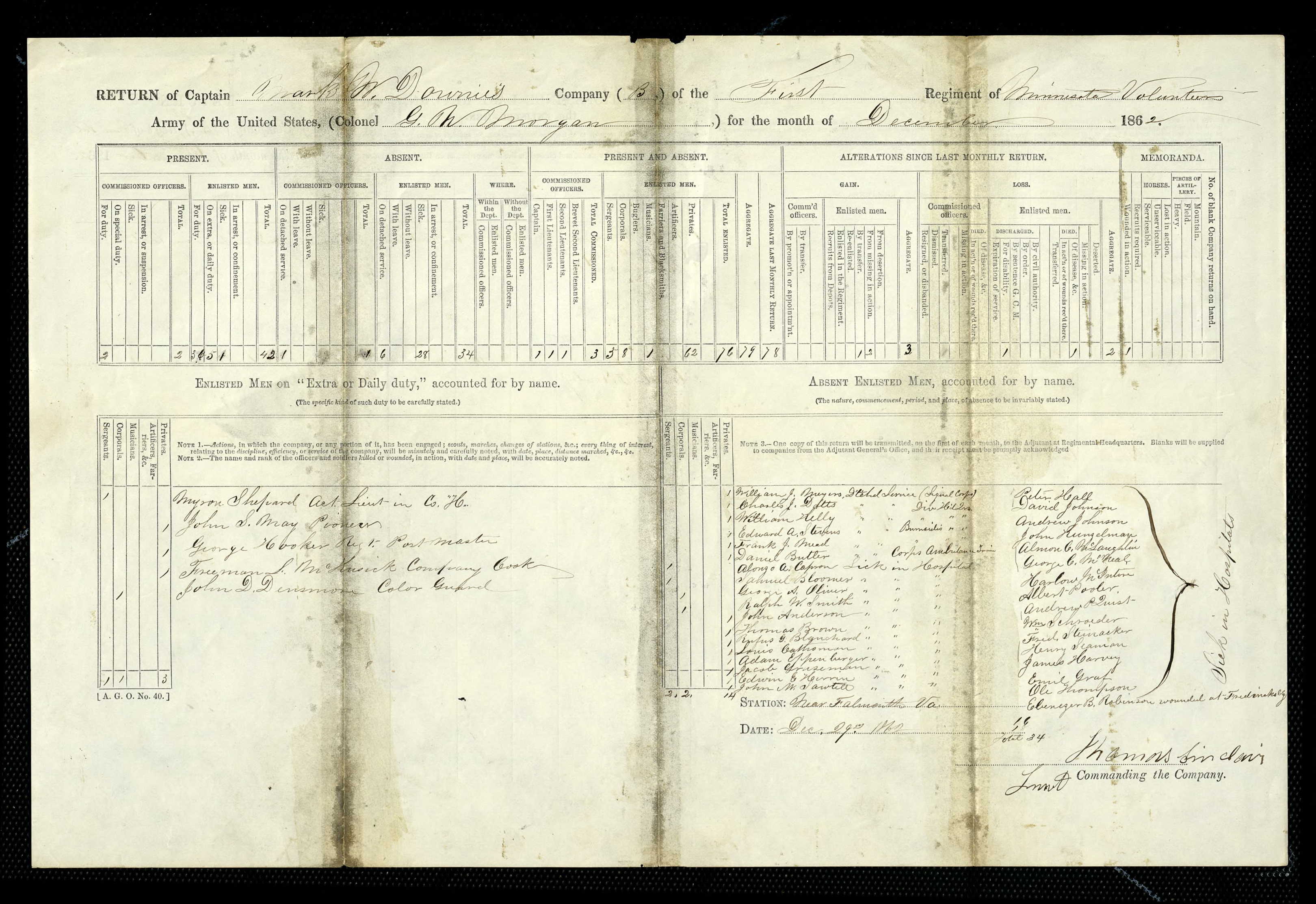
Almond on 1862 Company B Muster record (on bottom right)
Almond was discharged for disability in Washington DC on February 16, 1863. The listed disability was "Chronic Kidney trouble" and he was "Discharged on Surgeon's Certificate". There are two sources for the discharge information. The first is the 1890 census for Veterans and Widows of the Civil War which is below on this page. The other is his page on the website for the first Minnesota regiment. ().
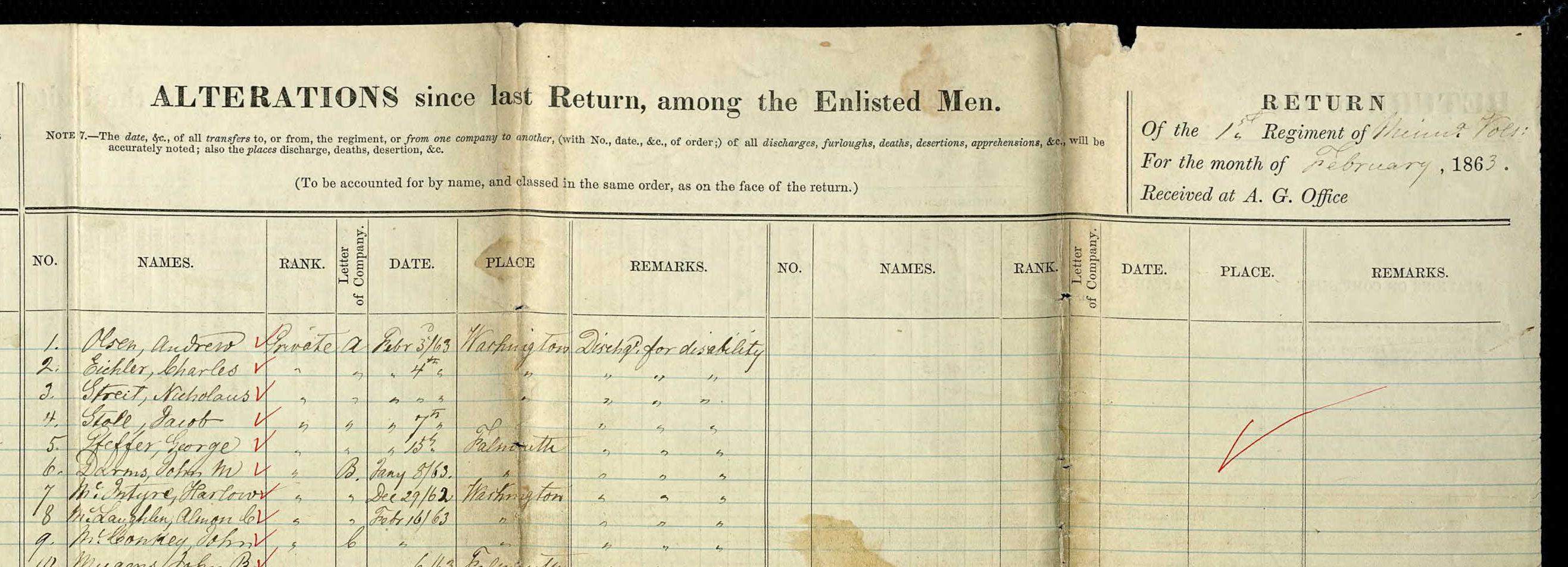
Almond's Discharge record(
Entire page
)
Although discharged for a disability, it is very likely a fortunate thing for Almond. He had survived three major battles without injury but his luck likely would have run out several months after the time of his discharge at the Battle of Gettysburg July 1-3, 1863. At this battle, the First Minnesota gained enduring fame as well as suffered horrendous casualties.
The regiment's role began with an inauspicious start with Colonel Colvill under arrest for ignoring General Gibbons orders before arriving at the battlefield. With the battle underway, Colvill requested and was granted release from arrest. The First was placed on the left flank of the Second Corps in support of Battery C of the Fourth U.S. Artillery. The men watched as the Third Corps fought a larger Confederate force until the corps was overwhelmed and fell to the rear. While Wilcox's Brigade paused to reform their lines before continuing the confederate attack, General Hancock arrived and surveyed the situation. He approached Col. Covill and ordered the regiment to take the confederate colors. Colvill ordered the men to advance at double quick until they were nearly in contact with the five confederate regiments. He then ordered them to level bayonets and charge. The rebels recoiled but then reformed and both sides exchanged fire within yards of each other. Only smoke and twilight save the regiment from complete destruction. Most officers and over 160 enlisted men were killed or wounded. The Minnesota 1st infantry regiment is best known for this dramatic charge at the battle of Gettysburg (source).

Muster-out Record of 1st Minnesota Regiment(
Entire page
)
After mustering-out Almond still had to register for the draft. Here is his Draft Registration for July 1863.
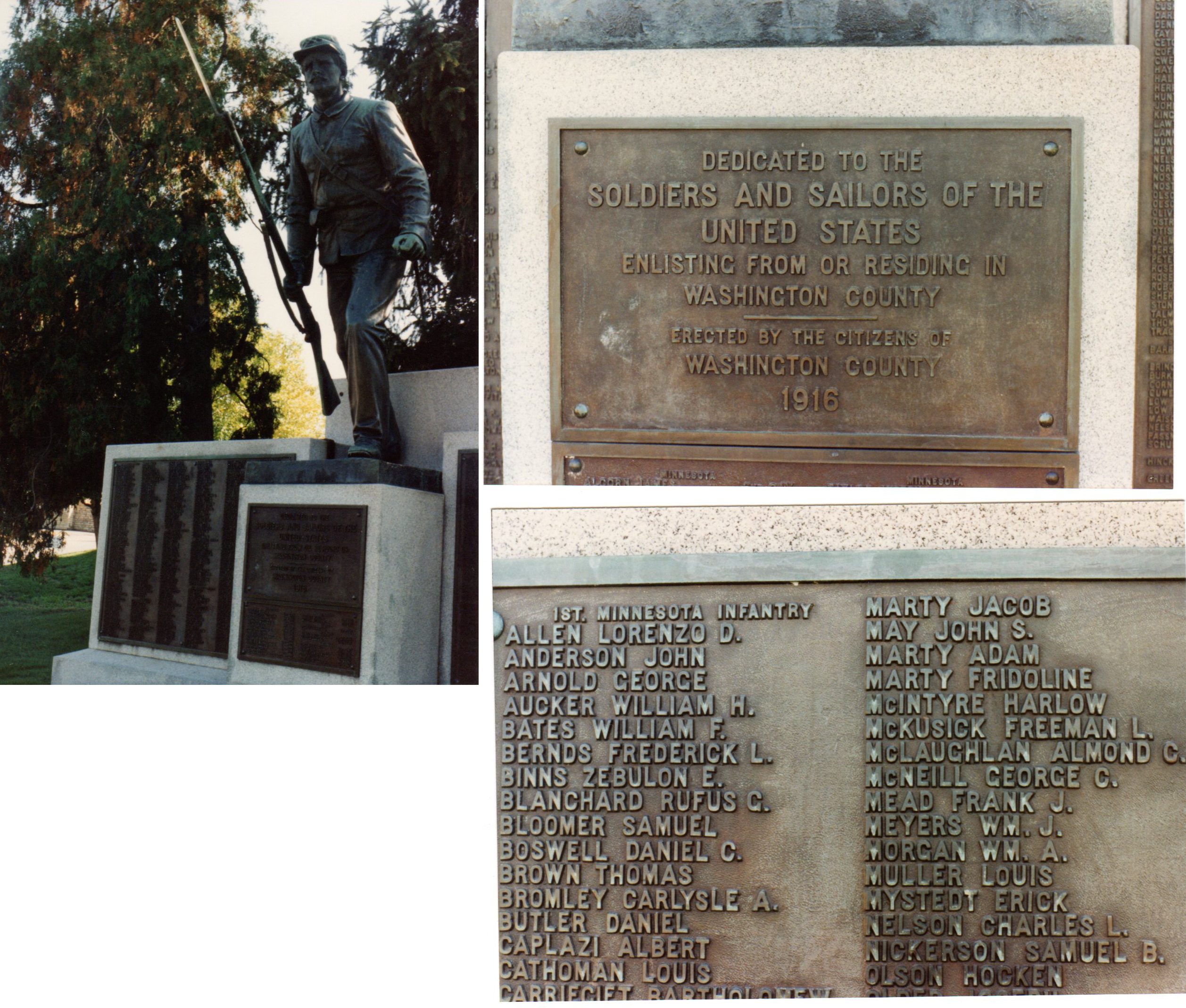
War Veterans Memorial, Stillwater Minnesota with Almond's name
After receiving his discharge, Almond returned to Washington County, Minnesota. On February 1, 1864 he married Maria Wells, also of Washington County, Minnesota.

Almond & Maria Marriage record(
Entire page
)
In September 1864, Almond and Maria moved to Dimmick, Lasalle, Illinois. They had 5 children:
Ernest Jerome McLaughlin (1865 - )
Harriet F McLaughlin (1866- 1943)
Edward McLaughlin (1868 - )
Almond Cole McLaughlin (1870 - )
Nellie Marie McLaughlin(1872 - 1963)
In the 1865 Illinois Census, taken on July 3, Almond and Maria are living in Dimmick, Lasalle, Illinois. The total number of people in the household is 3, so Ernest was been born by then. The value of their livestock is placed at $100.

Almond & Maria 1865 Census(
Entire page
)
In the 1870 US Census Almond and Maria were living in Troy Grove, LaSalle county, Illinois. Almond's occupation is listed as a Blacksmith while Maria's is keeping house. Almond's personal estate is listed with a value of $400. Their four oldest children were living with them.
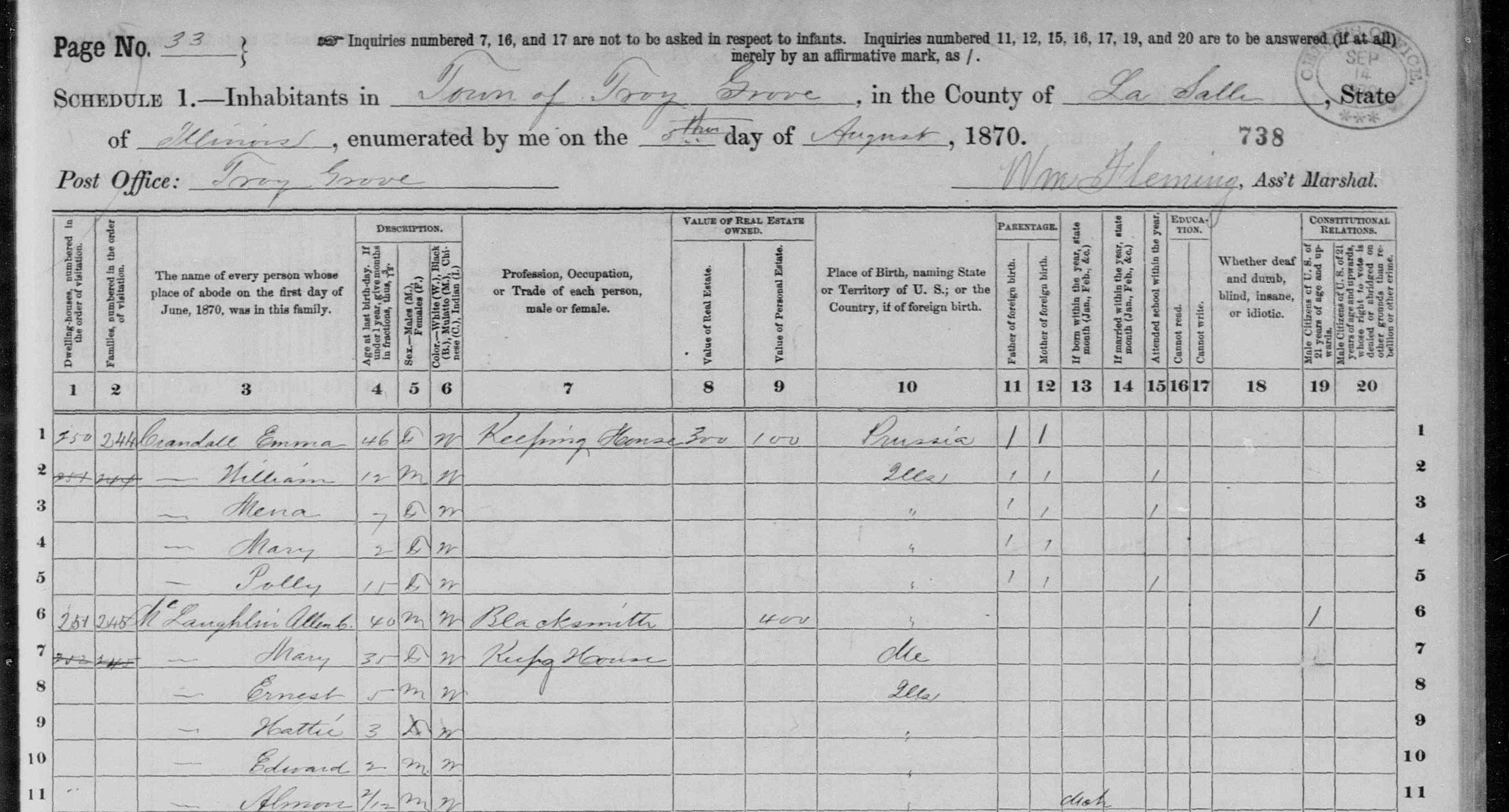
Almond & Maria 1870 Census(
Entire page
)
In 1872 their 5th and last child Nellie Marie was born. Maria died in the pregnancy with her 6th child in the 1873 timeframe. It seems the family broke up at this time and the children were all adopted out. We can see the family adopted out to various families in the 1880 census to below.
On Dec 30, 1874, Almond's older brother George signed an affidavit, which is an application for a marriage license for Almond and Catherine Barr from Lasalle county, Illinois. Note that the affidavit isn't stating their actual ages but noting they are at least of those ages. In the 1870 census George was also living in Troy Grove, Illinois.
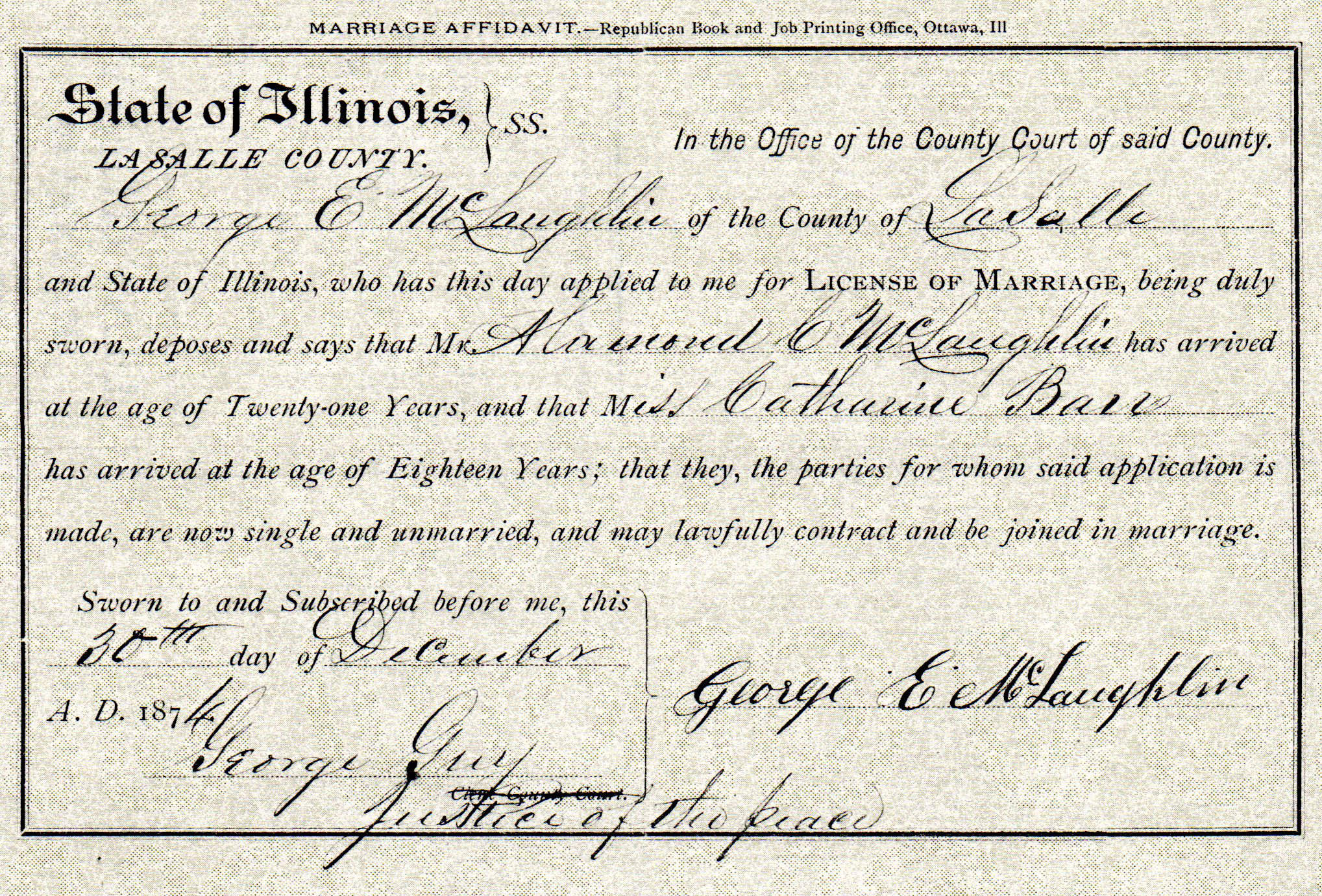
Almond and Catherine Barr Marriage Affidavit
3 Jan 1875 Almond married Catherine (Kate or Katie) Barr in Lasalle county, Illinois. The Marriage certificate is below.
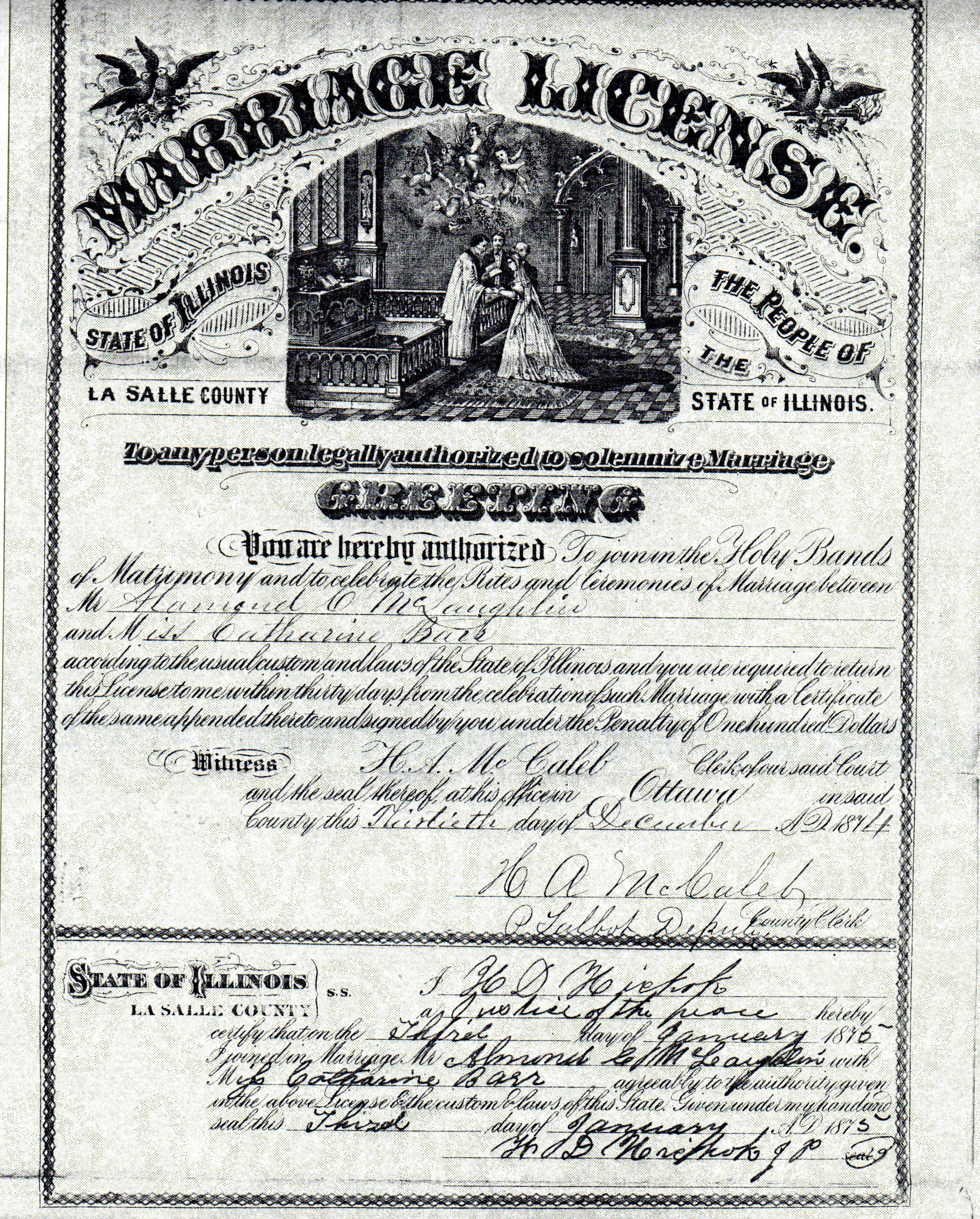
Almond and Catherine Barr Marriage Certificate
They had a child born 20 July 1878. On the birth certificate the mother's name is listed as Kattie H McLaughlin of Ohio born May 8, 1850. Her Maiden Name is listed as Kattie H Barr. Almond's occupation is listed as a Blacksmith. The child is listed as "infant" on the birth certificate with no sex specified. It is possible that Katie died during childbirth. The infant is believed to have died about 7 months later. This information is not known exactly but is speculated to be so here.
In the 1880 Census Almond was living alone in Mendota, Lasalle, Illinois. His occupation is a blacksmith. In this census he is listed as "Albert" instead of Almond.

Almond 1880 Census(
Entire page
)
In the 1880 census, Earnest, Almond's oldest child, age 15, was living with the family of Daniel Newman as a farm Hand in Lee Center, Lee, Illinois (source). Edward, age 12, was living with the William Reed family at Sparta, Randolph, Illinois and is listed as a "son" to William and Margret Reed (source). Harriet, age 13, is listed as "Hattie McLaughlin" a boarder with the Norman and Jane Matson family in Northville, LaSalle, Illinois (source). Nellie Marie, the youngest child, age 8, was living with her adopted parents Ferdenand and Betsey Davis in Princeton, Illinois(source).
In 1881 Almond married Emma Maria Charlton. The source of the date of marriage comes from Almond's obituary. It is believed they married in Mendota, Lasalle County, Illinois but I can't find a record of the marriage. Almond and Emma had five children. The oldest, Lyle Wayne was born in Mendota, Lasalle, Illinois. That Almond was living in Mendota at the 1880 census and that their oldest son Lyle was born in Mendota in 1882, is the basis for the belief that the marriage was also in Mendota.
Lyle Wayne McLaughlin (1882 - 1944 )
Freeman Alpha McLaughlin (1866- 1943)
HarryClyde McLaughlin (Hudson) (1870 - )
Dakota Blossom McLaughlin (1888 - 1989 )
Pierre McLaughlin(1890-1891)
In 1883 Almond, Emma and their child Lyle moved to Gettysburg, South Dakota. The rest of their children were born there. The Wikipedia entry for Gettysburg South Dakota states: "Gettysburg was platted in 1884. The city was named in commemoration of the Battle of Gettysburg. A large share of the early settlers were veterans of the Civil War".
In 1889 Almond applied for a pension as a veteran of the Civil War.
The 1890 US census was mostly destroyed in fire. However, in the 1890 census of Veterans and Widows of the Civil War, Almond is listed as living in Gettysburg, South Dakota. It is assumed the rest of the family lived with him.
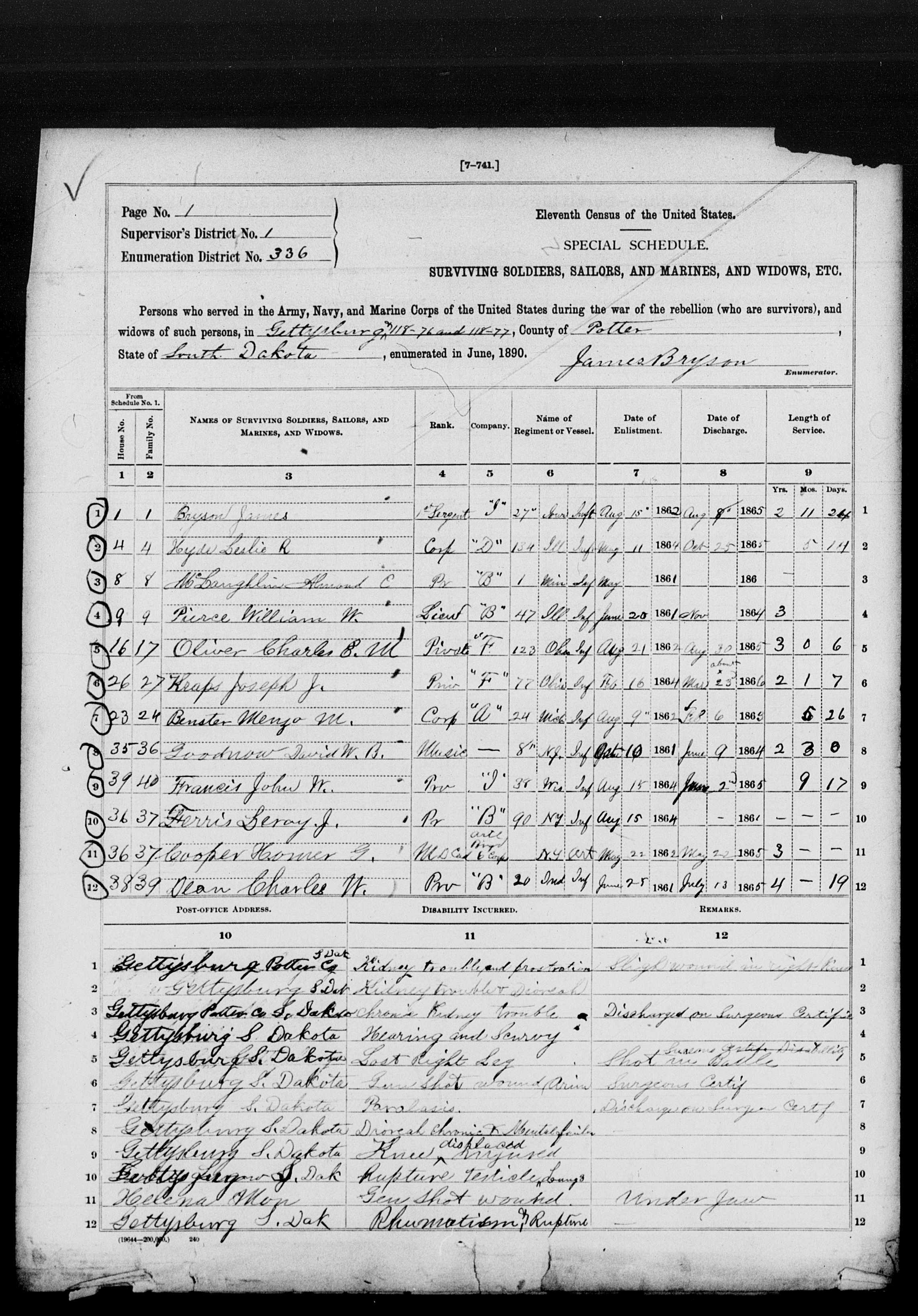
Almond 1890 Census
In April 1891 Emma died after a period of invalidism that lasted for several months(source1, source2 ). She was survived by her 5 children (source), although it is believed that Pierre also died in 1891. Like he did after his first wife died, Almond adopted out his children after Emma's death. Son HarryClyde McLaughlin (Hudson) was adopted out to the Reverend Metcalf (note that he officiated at Emma's funeral (source). Dakota Blossom was adopted out to Almond's brother in law J. R Earnest (source).
In the 1900 census, Almond was 60 years old, living at the Cheyenne River Indian Agency - Reservation. He is listed as a "servant" in the household of Silas Webb with an occupation of blacksmith.

Almond 1900 Census(
Entire page
)
Almond died January 16, 1905. He was three months shy of 65 years old when he passed away. From Almonds obituary:
"He came to Potter County in 1883 from Minnesota and has resided here since. He engaged in several occupations such as blacksmithing, but at the time of his death he was in the restaurant business. He died Monday morning, Jan. 16, 1905 at 8:15 from the effect of a paralytic stroke that he received the Wednesday before. His son Lysle was present at the time of his death having come for a visit the day before his father suffered the stroke. Another son, F.A. McLaughlin arrived from Madison Monday night after his father's death. The funeral was held Tuesday afternoon at 1 pm in the W.R.C. (Women's Relief Corps) Hall with the G.A.R. (Grand Army of the Republic) Post in charge (he was a member of the G.A.R. post) and Rev. Norton preached the sermon. He was laid to rest in the Gettysburg Cemetery. He had homesteaded the NW quarter of section 12 in Artichoke Township (Potter County, SD) and the NW quarter of section 20 in Cunningham Township (Potter County, SD)."
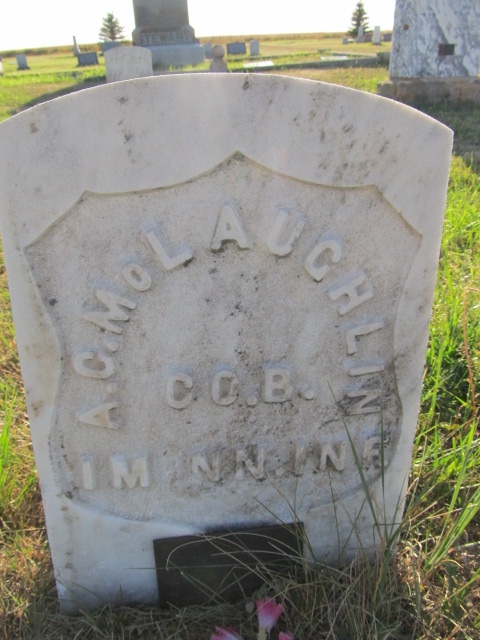
Almond's grave stone
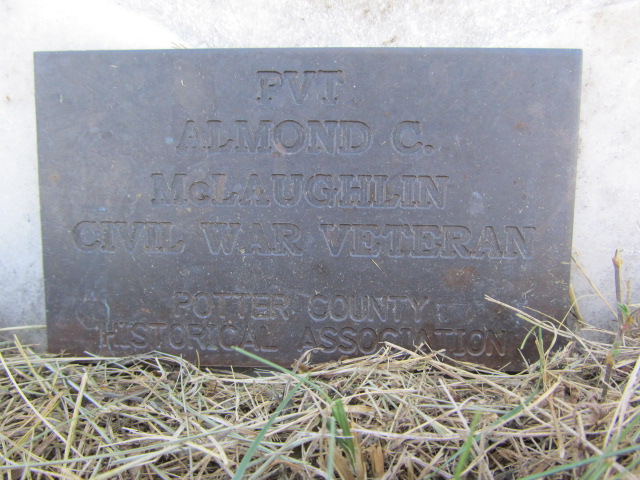
Closeup of the plaque at the bottom of the grave stone